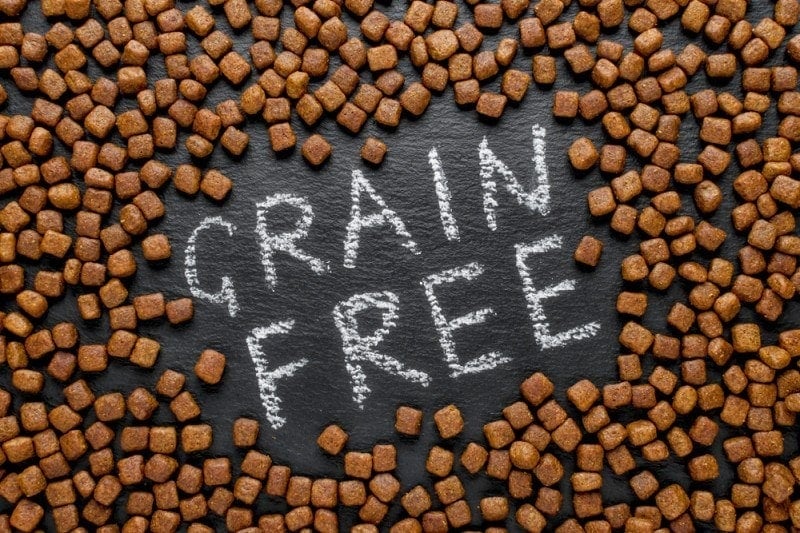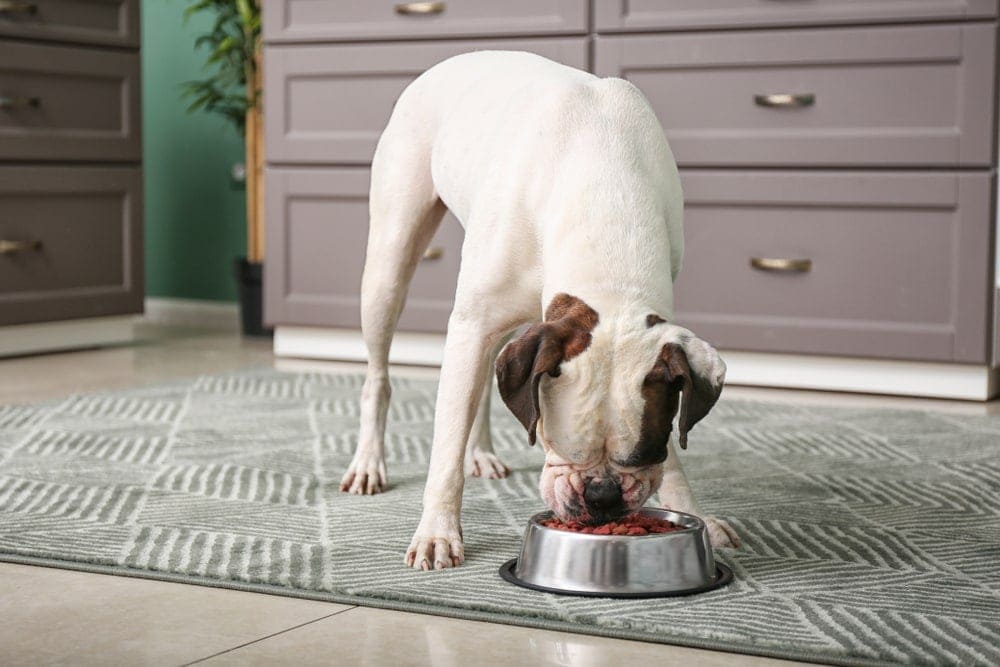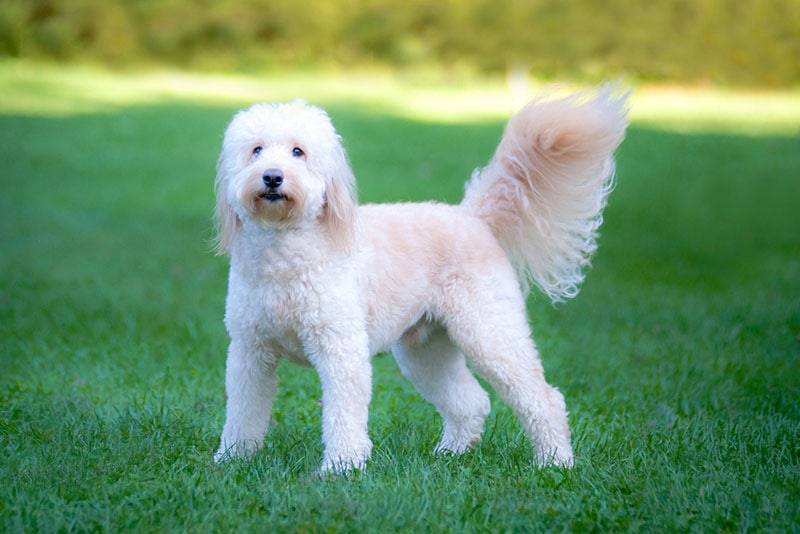5 Health Benefits of Grain-Free Dog Food: Advantages & Disadvantages

Updated on

Click to Skip Ahead
Grain-free diets are among the many choices that dog owners have when it comes to selecting their pup’s meals. Like with any other option, you need to sort out the benefits of grain-free dog food from the disadvantages.
Think about what your dog needs as well. Each pup is different from another, even inside the bounds of the same breed. Feeding them a primed, personalized diet helps keep them in better shape, perhaps lessening the impact of health issues later in life. First, we’ll look at the five benefits of grain-free dog food. Then, we’ll cover the three potential downsides of grain-free dog food.
What Is the Difference Between Grain and Grain-Free?
Many companies and dog-devotees alike call dog food with grain in it “regular dog food,” since it has been the typical formula used for dog food. It is a popular diet to choose even though there has been a significant movement toward a grain-free diet.
- Corn
- Wheat
- Soy
- Barley
- Rice
- Oats
- Rye
There are also options that list themselves as “gluten-free.” These still contain grains but won’t contain wheat since that has gluten.
Grains provide carbohydrates and fiber. They help promote digestion and fill your dog with the beneficial energy typical of carbohydrates. They supplement the quantities of protein in kibble and linoleic acid, which is a fatty acid essential for dogs.
Grain-free foods must work to replace these carbohydrates. They source them from different plants instead. Sometimes, this can be a highly beneficial aspect of the food. At other times, though, keeping the grains in the formula would be just as healthy, if not more so.

The 5 Benefits of Grain-Free Dog Food
If you struggle to find the right mix for your dog, think about your pup’s health. Do they require something specific from their food because of their size or breeding? Do they have any allergies?
1. It Supports a Healthy Coat and Skin
The natural oils that a dog’s skin produces are essential to a lush coat of healthy fur. These oils spread from the skin up to the rest of the follicle. They protect the hair, strengthen it, and stop it from getting brittle and breaking off.
The skin needs a little aid to produce the best oils. Getting the right kinds of oils in their diet helps supply this need. Omega-3 fatty acids are the most advantageous for this goal. It is supplied in things like animal fat, as well as flaxseed, in greater supply than any grain.

2. Easy on the Digestive System
Everyone can agree that it has been many hundreds of years since most of our domesticated canine species have been wild. However, they still have the influence of their wolfish ancestors with their high-protein needs. Their stomachs are not created in a way that best supports breaking grains down.
Corn and wheat can have their benefits, but many dog companies use them as fillers instead of supplements. That amount of grain in your dog’s diet makes it difficult for them to digest these foods. If you notice your dog suffering from inflammatory issues, rashes, or other gastrointestinal problems, you might want to test taking the grain out of their diet.
3. It Reduces Risk of Allergies
People do not think about it often, but dogs are prone to dealing with allergies. Frequently, these can be exacerbated or even caused, by their diet, especially one that includes grains. Allergy symptoms that you may notice could be:
- Diarrhea
- Constipation
- Excessive gas
- Skin rash
- Frequent infections
- Vomiting
For some of these, such as excessive gas, there are breeds who struggle with this more than others. Giving them a high-quality food that you can find without any common gas-related foods may help this.
4. It Has a Special Formula
Companies that have begun to generate formulas without grains have had to take a specific look at replacements. They need to maintain the carbohydrate level in the food but remove the harmful aspects that grain can wreak on a dog’s stomach.
Many times, the formula is more thought out and healthier for your pup. They use things like sweet potatoes and fish oils to get the same effect as grains but better.
5. It Packs a Higher Nutritional Punch
Things like sweet potatoes that are high in carbohydrates are much more nutrient dense than grains tend to be.
Often, the higher nutritional value goes hand in hand with a higher price tag. But if it satisfies your pup’s dietary needs without requiring additional supplements to their daily diet, then many believe it to be worth it.
The 3 Potential Disadvantages of a Grain-Free Diet:
In contrast, there are also several reasons that a grain-free diet might not be the best choice.
1. It Lacks in Balance
There is a reason that for many years, kibble with grain in the recipe was the norm. Many companies figured out a healthy, balanced formula. This focus wasn’t true for all companies that use grain in their food.
Grains are packed with omega-3 fatty acids, along with potassium and select vitamin B, such as 6 and 12. When you take out the grain, companies need to find a way to replace it. They have to find a new balance for the recipe. Not all of them have done this, and it is a risk that you should consider.
2. It Is a Different Source of Carbohydrates
Since no additive is only a pure carbohydrate, they always come in a natural form. Whether it is from grains, peas, or potatoes, the carbohydrates come with other compounds.
Some companies have replaced the grains with carbohydrate sources filled with starches. Just as some aspects of grain are negative for your dog’s digestive system, so are starches. They can cause unhealthy amounts of weight gain. Make sure that whatever dog food you use adds a healthy grain substitute.
3. It Has a Premium Cost
The premium value of some of the replacements for grain can give a buyer a shock the first time that they check out the price tag. The price of such grain-free selections needs to be weighed against the health of your pup.
Some vets will point out that if you buy a premium food that has been proven to be a healthy dietary choice, you may actually save money in the long run. Instead of having to pay for big-ticket vet trips, the diet is one that supports your pup into their old age. These premium foods often have smaller portion sizes as well.
Swapping from one food to another or maybe picking one out for the first time can be a leap. Figuring out your dog’s needs, as well as their likes and dislikes, often helps narrow your choices. Consider them first, since they are going to have to eat it every day for many weeks and months to come.
Featured Image Credit: nadisja, Shutterstock











